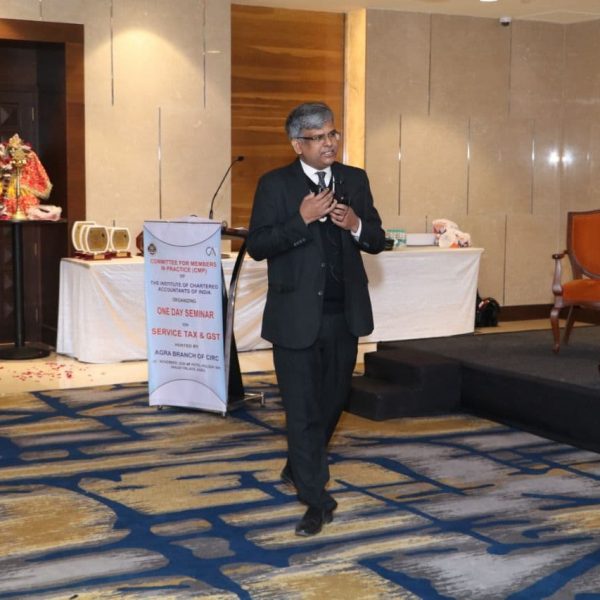Faceless E–Assessments under income tax
Author (CA P P SINGH). @ 9711521060, 9871229590 or cappsingh@gmail.com
“Para 124. The existing system of scrutiny assessments in the Income-tax Department involves a high level of personal interaction between the taxpayer and the Department, which leads to certain undesirable practices on the part of tax officials. To eliminate such instances, and to give shape to the vision of the Hon’ble Prime Minister, a scheme of faceless assessment in electronic mode involving no human interface is being launched this year in a phased manner. To start with, such e-assessments shall be carried out in cases requiring verification of certain specified transactions or discrepancies.
Para 125. Cases selected for scrutiny shall be allocated to assessment units in a random manner and notices shall be issued electronically by a
Central Cell, without disclosing the name, designation or location of the Assessing Officer. The Central Cell shall be the single point of contact between the taxpayer and the Department. This new scheme of assessment will represent a paradigm shift in the functioning of the Income Tax Department.” Extract from budget speech of Hon’ble union finance minister on 5th July 2019
Introduction: Two Central processing units (here –in- after referred as CPC) one in Bengaluru for the processing of income tax return and other in Ghaziabad processing of TDS statement already properly functioning and as extension now union government has set up national e-assessment centre in New Delhi and 8 regional centres for handling the assessment without physical human interface or minimum interface with video conferencing or video callings. According enabling provisions has been made and implemented for that and in future the government is acting upon faceless appellate proceedings as well with least human interaction in the appellate system, the system pertaining to the E-assessments are dealt with in this article.
What is E- assessment?
Firstly it is important to understand the term assessment. Assessment means the determination of income or loss of taxpayer on after allowing all deduction, exemptions, permissible set off intra head or inter head under the provisions of income tax. “e-assessment” means the assessment proceedings conducted electronically in ‘e-Proceeding’ facility through assessee’s registered account in designated portal . Now the government has shifted from the manual assessment process to the E-assessments for several rreasons, discussed in the following paragraphs.
Why E-assessment scheme?
E-assessment is required to impart greater efficiency, transparency and accountability by way of Firstly by eliminating interface between Assessing Officer and assessee to the extent technologically feasible Secondly by Optimising the utilisation of resources through economies of scale and functional specialisation of tax officers & thirdly by Introducing team based assessment with dynamic jurisdiction. Now the success of the a scheme shall depend upon the cooperative attitude of the tax officers as well as success of the technological systems and the convenient and hassle free support to the tax payers in the initial years of the system
Legal Framework of E-assessments: It is interesting to note that suitable amendment has been made in the income tax act for the E-assessments scheme. Three new subsections has been inserted in section 143 after subsection 3, though the legal provisions are explained in this paragraph
POWER TO MAKE SCHEME: section 143(3A) [(3A) empower the Central Government may make a scheme, by notification in the Official Gazette, for the purposes of making assessment of total income or loss of the assessee under section 143(3) so as to impart greater efficiency, transparency and accountability by—
- eliminating the interface between the Assessing Officer and the assessee in the course of proceedings to the extent technologically feasible;
- optimising utilisation of the resources through economies of scale and functional specialisation;
- Introducing a team-based assessment with dynamic jurisdiction.
Considering the above power NOTIFICATION NO 61/2019 dated 12-09-2019 issued enabling e-assessment scheme which has details provisions pertaining to the a scheme.
Section 143(3B) empower to modify the applicability of other provision of The income tax Act to implement the e-assessment scheme by notification in the Official Gazette relating to assessment of total income or loss Accordingly the provisions shall apply such exceptions, modifications and adaptations as may be specified in the notification. To implement that NOTIFICATION NO 62/2019 dated 12-09-2019 as corrected by notification no 86/2019 issued modifying the applicability of other provisions of the IT Act like modifications of provisions of section 2(7A), section 92CA, section 120, section 124, section 127, section 129, section 131, section 133, section 133A, section 133C, section 134, section 142, section 142A, section 143, section 144A, section 144BA section 144C and Chapter XXI of the Act. Further government has fixed a timeline that no direction shall be issued after the 31st day of March, 2022.
Further for the empowerment of the notification issued provision has been made in section 143 (3C) that Notifications issued u/s 143(3A) or (3B) shall be laid down in parliament as soon as may be after the notification is issued, be laid before each House of Parliament.]
E-Assessment Structure: e- Assessment organisation’s structure shall consist of (a) Taxpayer who interact with national e-assessment centre –NeAC (b) Regional E- assessment centre-ReAC having 4 units like Assessment Unit, Verification Unit, Technical Unit and Review Unit
Functions of NeAC at New Delhi headed by Pr. CCIT shall be (a) to Specify format, mode, procedure and processes (b) Send all notices/communication electronically to the tax payer (c) Assign cases to assessment unit (ReAC) through automated allocation system(d) Allocate cases to verification unit, technical unit through automated allocation system(e) Select draft assessment orders for review and allocate to review unit through automated allocation system(f) Providing opportunity to taxpayer before finalising assessment order (g) Finalize assessment orders(h)Transfer all electronic records to jurisdictional AO for post assessment work like, imposition of penalty, Collection and recovery of demand, rectification of mistake if any in the order u/s154, giving effect to appellate orders, submission of remand report if so required by Appellate authority like CIT( appeal), or any other report to be furnished, or any representation to be made, or any record to be produced before the Commissioner (Appeals), Appellate Tribunal or Courts, as the case may be; proposal seeking sanction for launch of prosecution and filing of complaint before the Court;
Note: It is important to note that NeAC & ReACS will not do any post assessment work and post assessment work are to be performed by jurisdictional tax officer only, even the penalty proceedings are being in the office of jurisdictional tax officer, this may lead to the harassment of the taxpayer.
Regional E-assessment centres ( ReAC) 8 in numbers which may likely to increase in future. ReACs shall be Operative at Delhi, Mumbai, Chennai, Kolkata, Ahmedabad, Pune, Bangalore, and Hyderabad headed by CCIT at each regional ReAC. Such ReAC shall have fourr units for different functions such as Assessment Unit to Identify issues in the case , seek information and analyse material to frame draft assessment orders, Verification Unit to Conduct enquiry, examination of books of account, examination of witnesses and recording of statement (through VC) etc.; Technical Unit to Provide advice on legal, accounting, forensic, Information Technology, Valuation, Transfer Pricing, Data Analytics etc. and the Review Unit to Review the Draft Assessment Order, Whether material evidence brought on record, points of facts and law incorporated, application of judicial decisions considered, arithmetic correctness etc. All these units will interact electronically to the NeAC.
Expected Benefits of E-assessment: It is expected that the life of taxpayer become easy so that taxpayer would devote time on work of business, profession or employment rather than visiting the tax Department and waiting for a long time there. Further there will be enhancement of Specialisation in the tax Department and the efficiency will also improve of the tax officers as well. Besides some other benefits are also expected like reduction in harassment since no human interface, increase Transparency and efficiency, Functional Specialisation of officer will result into Improvement in Quality of Assessment, focused Risk based approach to detect leakage of revenue ,Systematic and specific verification, Standardisation and quality management, better monitoring and expeditious disposal of Cases etc.
Limitations & difficulties: It is not an easy task to implement the scheme successfully because there are so many divergent view of different high Courts and the tribunal on the different issues of income tax. In the case of dynamic jurisdiction, the officers may not be aware of the judicial precedents applicable on a particular taxpayer. The technological upgradation across India is not at same level and therefore taxpayer may fill difficulties in filing the documents particularly where large file to be uploaded, at the same time tax officers also fill difficulties in understanding all the information in the voluminous documents provided by the taxpayer So personal hearing is desirable and there is no alternate of the personal hearing, assessment could not be finalised merely on the basis of written submissions without oral discussion.. Further due to natural calamities in the different part of our country may lead to non-compliance within a specified time period of 15 days for the compliance and I’ feel the period for submission of should be reasonable because sometimes the taxpayer have to arrange documents and information from others.
Conclusion: Only written submissions can’t be the base to complete the assessment, it is essential to provide personal hearing also, if anything against the assessee in the draft assessment order so as to follow the principle of natural justice in true sense as it was held by Hon’ble SC in several judgements because there are chances that tax officer may not understood the written submission in right sense in right manner. Further on the same point there are divergent view of different high courts and tax officer must take care of such judicial precedent while finalising assessment order and imposing only their own views on the tax payer.










